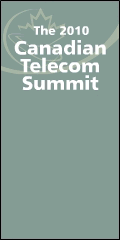Monday, March 03, 2008
Not as many towers to share
 As expected, Industry Canada released its final Conditions of Licence for Mandatory Roaming and Antenna Tower and Site Sharing and to Prohibit Exclusive Site Arrangements on Friday.
As expected, Industry Canada released its final Conditions of Licence for Mandatory Roaming and Antenna Tower and Site Sharing and to Prohibit Exclusive Site Arrangements on Friday.These rules were initially going to make every tower in Canada available for sharing by mobile service providers - providing two benefits: easier entry for winners of spectrum in the upcoming auction; and, reducing the proliferation of towers that nobody wants in their backyard.
Industry Canada backed down from its original intent to apply the new sharing conditions on all current spectrum holders: broadcasters, utilities, emergency service radios, among others. Instead the rules will only be applied among mobile license holders.
The public utilities had complained that:
Public utilities noted that their sites are generally located within the confines of enclosures around utility installations (e.g. hydroelectric transformers and switching facilities). Admission to such enclosures is highly restricted and requires and could compromise the integrity of critical utility infrastructure.The others had similar cop-outs:
Public safety agencies expressed similar concerns to those applicable to national security sites requiring highly restricted access. It was also submitted that broadcast sites already tend to be the subject of extensive sharing among broadcasters for technical and economic reasons while generally being poorly suited for other radiocommunication system architectures.So what?
Industry Canada could have kept to its principles. Tower owners could easily impose conditions on which crews are permitted to perform installation and maintenance in order to deal with the "specialized training, equipment and procedures to protect personnel." If the broadcast towers aren't suitable for other "radiocommunication system architectures" then there won't be many requests. These could all of been handled in the course of operators requesting access and tower owners responding with conditions in their proposal.
Why did Industry Canada back down?
Technorati Tags:
Industry Canada
Comments:
<< Home
The tower sharing/siting issue is going to get even more complicated if Toronto's Council approves a recommendation of the Board of Health that calls for the adoption of the Prudent Avoidance Policy on Siting Telecommunication Towers and Antennas and the use of the new City of Toronto Telecommunication Tower and Antenna Protocol during its meeting that begins today. The Policy and Protocol are to be used as a mechanism for collecting
information on the estimated levels of radiofrequencies (RF) around proposed cell phone towers and antennas in areas where people normally spend time in order to monitor the potential impact of proposed telecommunications facilities in Toronto and to encourage voluntary adoption of the Prudent Avoidance Policy.
The Board of Health adopted this recommendation at its meeting of December 4th where the only submission considered was that of the Medical Officer of Health who also was the only speaker. The Prudent Avoidance Policy on Siting Telecommunication Towers and Antennas was recommended to the Board of Health by the Medical Officer of Health at a meeting held on November 20th.
The Policy's approach is to keep radiofrequency levels in areas where people normally spend time at least 100 times lower than
Health Canada's Safety Code 6 limits when siting new telecommunication towers and
antennas in the City of Toronto. In additon to this, the recommendations Council will be cosndiering include: (i)recommending to Health Canada that public exposure limits for RF fields under Safety Code 6 be made 100 times more strict as previously recommended by the Board; (ii)recommending to cell phone carrier proponents to consider voluntary adoption of the
Prudent Avoidance Policy when proposing sites for new telecommunication towers and
antennas, including considering proposed alternative sites when the City's review identifies potential concerns; and (iii)encouraging Industry Canada to conduct regular monitoring for radiofrequencies arising
from telecommunications structures in Toronto, and to make that information publicly available.
The Board of Health's submission to Council notes that recent scientific literature indicates that uncertainties in the science remain and that Health Canada has
not revised its guidelines to address the concerns raised in
1999. It also notes that authority for regulating telecommunications towers rests with Industry Canada, whose “Client Procedure Circular”
allows local planning authorities, such as the City of Toronto to comment.
Looks like more red tape and delays.
information on the estimated levels of radiofrequencies (RF) around proposed cell phone towers and antennas in areas where people normally spend time in order to monitor the potential impact of proposed telecommunications facilities in Toronto and to encourage voluntary adoption of the Prudent Avoidance Policy.
The Board of Health adopted this recommendation at its meeting of December 4th where the only submission considered was that of the Medical Officer of Health who also was the only speaker. The Prudent Avoidance Policy on Siting Telecommunication Towers and Antennas was recommended to the Board of Health by the Medical Officer of Health at a meeting held on November 20th.
The Policy's approach is to keep radiofrequency levels in areas where people normally spend time at least 100 times lower than
Health Canada's Safety Code 6 limits when siting new telecommunication towers and
antennas in the City of Toronto. In additon to this, the recommendations Council will be cosndiering include: (i)recommending to Health Canada that public exposure limits for RF fields under Safety Code 6 be made 100 times more strict as previously recommended by the Board; (ii)recommending to cell phone carrier proponents to consider voluntary adoption of the
Prudent Avoidance Policy when proposing sites for new telecommunication towers and
antennas, including considering proposed alternative sites when the City's review identifies potential concerns; and (iii)encouraging Industry Canada to conduct regular monitoring for radiofrequencies arising
from telecommunications structures in Toronto, and to make that information publicly available.
The Board of Health's submission to Council notes that recent scientific literature indicates that uncertainties in the science remain and that Health Canada has
not revised its guidelines to address the concerns raised in
1999. It also notes that authority for regulating telecommunications towers rests with Industry Canada, whose “Client Procedure Circular”
allows local planning authorities, such as the City of Toronto to comment.
Looks like more red tape and delays.
Further to yesterday's note, I have discovered that there was supplementary material put related to the Proposed Protocol for the
Installation of Telecommunications Towers on the agenda of Toronto's Council meeting of yesterday and today. That material can be found at:
http://www.toronto.ca/legdocs/mmis/2008/cc/bgrd/pg13.2d.pdf
It appears that there have been dicsussions between the wireless carrier industry (Bell, Rogers and Telus) as represented by the law firm of Thomson Rogers, and the city's Planning Division. From these discussion it has been agreed that those towers exempt from municipal review by Industry Canada will not fall under the Protocol. As a result, a revised version of the Protocol will be considered by Council. This revised version can be viewed at the site noted above as can the positions of city staff with respect to the other issues the wireless carriers have identified.
Happy reading.
Post a Comment
Installation of Telecommunications Towers on the agenda of Toronto's Council meeting of yesterday and today. That material can be found at:
http://www.toronto.ca/legdocs/mmis/2008/cc/bgrd/pg13.2d.pdf
It appears that there have been dicsussions between the wireless carrier industry (Bell, Rogers and Telus) as represented by the law firm of Thomson Rogers, and the city's Planning Division. From these discussion it has been agreed that those towers exempt from municipal review by Industry Canada will not fall under the Protocol. As a result, a revised version of the Protocol will be considered by Council. This revised version can be viewed at the site noted above as can the positions of city staff with respect to the other issues the wireless carriers have identified.
Happy reading.
<< Home









